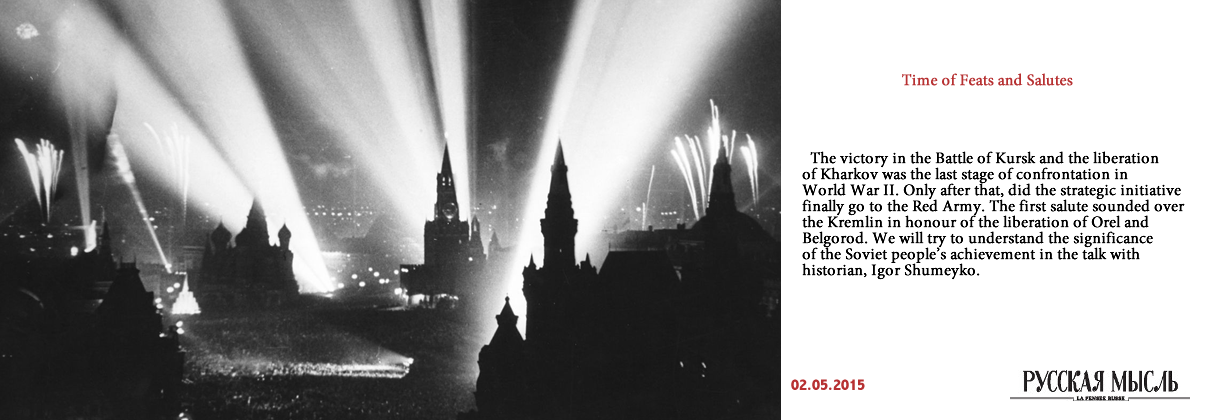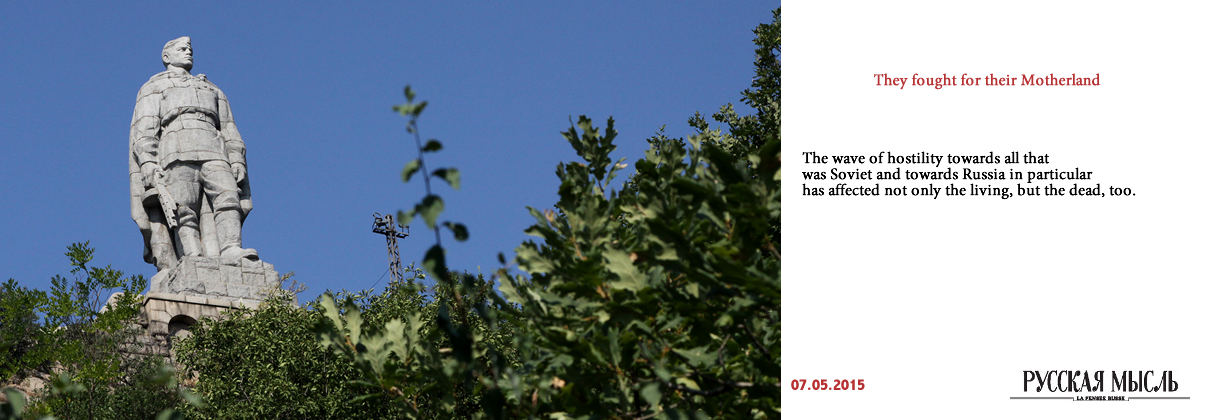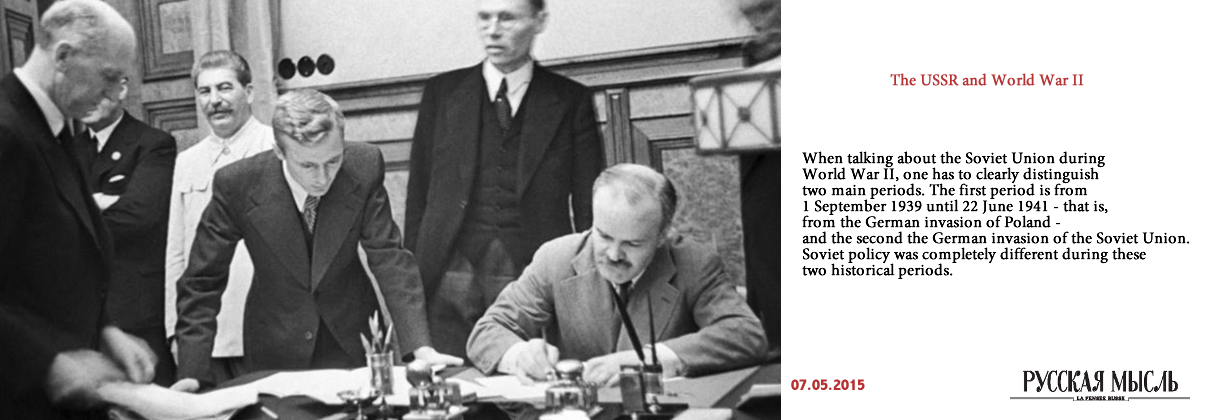Author: Arseny Zamostyanov
If it is not something to take pride in, then what could be?
The victory in the Battle of Kursk and the liberation of Kharkov was the last stage of confrontation in World War II. Only after that, did the strategic initiative finally go to the Red Army. The first salute sounded over the Kremlin in honour of the liberation of Orel and Belgorod. We will try to understand the significance of the Soviet people’s achievement in the talk with historian, Igor Shumeyko.
– Igor Nickolaevich, we are celebrating the 70th anniversary of the campaign of 1943, the culmination of which took place in July and August. How do you assess the tactical and strategic results of the confrontation? Today some people want to take a fresh look at this Battle…
– It has been said for decades that “the Battle of Kursk was the final turning point in the World War II.” Yes, the definition is Soviet, and without a drop of sensationalism, but exactly this is also repeated in the memoirs of German generals.
For example, Guderian writes (in “Memoirs of a Soldier”): “We suffered a decisive defeat. Armored forces, supplemented with great difficulty, because of the large losses and of life and material, were put out of action for a long time… From that time, the enemy undoubtedly mastered the initiative. “
Manstein writes (in “Lost victories”): “This was the last attempt to maintain our initiative in the East. With its failure, the initiative finally passed to the Soviet side. Therefore, the operation “Citadel” was a decisive turning point in the war on the Eastern Front. “
And if both sides have agreed with the assessment, then we have to ask ourselves – for whose sake should it be corrected? Those who try to downplay the significance of the Kursk Bulge, are not working on a factual basis, but playing a game with selected facts, giving deliberately false interpretations.
In general, in estimating of any act in the nature of competition (battle, elections, football match), the result has only two main versions: a winner and a loser. The pride, perhaps boasting of one must be compared with the excuses of the other, and contradictions must be tested. But where do we go from there? Do we pay heed to the versions of outsiders, just because they have the resources to make their voice heard? So we should consider the matter of such assessments as closed. They were formulated in the early postwar decades.
Another thing is that in the perception of the outcomes we can see an interesting paradox. One German diplomat, Joachim Engelmann, talks about it: “Strangely enough, the Battle of Kursk, in spite of its size and importance, was not included in the minds of the German people as a” fatal ” Battle of Stalingrad, the memory of which haunts the people.” Moreover, in Paris, there is a metro station “Stalingrad” but there is no a station “Kursk”.
– Maybe because in Stalingrad everything was gathered in one point, whereas the Battle of Kursk was geographically more stretched out, but there are still certain heroic names: Kursk, Prokhorovka, Belgorod, Orel, Kharkov … On the whole, the victory of the Red Army in the summer of 1943 had no less impact in the world than Stalingrad.
– The resonance was huge, hence the diversity in the versions of the events. Before the talk, I revised the summary of figures and was once again convinced: there are not simply many private assessments but there seems to be no limit in their number. New researchers will be born but they will not stop the old from being heard. And we all waste our time saying: “And according to the calculations of such and such, and so on …”
There is a generalized Soviet assessment.
The Germans. Army Groups “Center” and “South” had 50 divisions (16 tanks), 900, 000 people, 10,000 guns and mortars, 2,700 tanks and assault guns, and more than 2,000 aircraft.
The Russians. Central and Voronezh Fronts: 1,300,000 people, 20,000 guns and mortars, 3,300 tanks and self-propelled guns, 2,650 aircrafts.
The Germans lost 30 divisions (7 tanks), more than 500,000 people, 1,500 tanks, 3,000 guns.
– What chances of success did the Reich have at the beginning of the operation on the Kursk Bulge? Tell us about the balance of power, mobilized and technical capabilities.
– We can find an objective assessment of the chances in the work of German historian Horst Scheibert: “It would be better to keep the German tank forces at the starting positions and allow the Russians to deploy the attack, and then apply counterattacks, than try to go on with the Russian peace negotiations. However, Hitler did not come to this understanding.
The best German strategist Manstein talks about this: there would have been some chances, if we had saved more of the energy resources of Western Europe and the East had to be stabilized.
American historian Alexander Bovin says: “The defeat at Stalingrad had to convince Hitler that there was no hope of a successful outcome of the war in the East. At the same time the command of the Western allies were reported so carefully, as to offer him a chance to correct, with the help of defensive action, many of the strategic mistakes that Hitler committed in the reckless attack.
Of course, Hilter had no chance to win. But Germany could stabilize the front in the West, if the Führer turned most of his army from the East to prevent landing operations of Anglo-American troops. Turning to the strategic defense on the Eastern Front, not taking offensive operations that could absorb all the remaining Germans strike force, Germany could deter the Soviet Union as long as it wasn’t tired of the war. However, such a turn would require Hitler to understand that he made a mistake, and the Führer could not do this. On the contrary, in spring of 1943, he began to gather the crumbs of his remaining troops to deal a decisive blow to the Red Army in the Kursk Bulge. “
Result: Hitler, wishing a decisive victory and not stabilization, drove too much power in the East and lost strength and opportunities.
You know, counting “Chances” – this is speculation. TV people once asked me to count the chances of the Germans in the Battle of Stalingrad… Taking Stalingrad, cutting off the Volga – meant cutting the oil off from the Soviets? Without oil, as you know, the “war of machines” would be completely lost … … So the Germans could win? There is the conclusion of historians and experts: the defeat at Stalingrad, the loss of oil would force the Soviet Union to surrender. Well, what can I say? Denying the chances of the enemy – so downgrading your victory. I brought the oil as the answer. Among the measures taken by the Russians, there were: trains and tanks were brought brought into the Caspian Sea – on the arithmetic mean calculation of specific weights of steel and oil, tanks were not completely drowned. For example, the waterlogged string tug pulled into Astrakhan, then – again on the rails and into the depths of Volga steppes. And there were special holes for the oil. Then the oil was poured there – and the procedure was repeated many times. That’s the only thing I could say about the oil and … determination, persistence, an inflexible noble spirit. I also told this story to Western historians. They were shocked by the combination of ingenuity and “barbaric determination”. Then they said something like: it’s the other reality, another war and the winner of that war might be Russia.
– As it was in the industrial war, which by 1943 had reached unprecedented stress … How had it been possible to beat the Germans in the war of machines in this difficult economic situation?
– An example with tanks and an of resolution shows the mobilization capabilities of participants. Here, of course, we can give a table of all necessary facilities for the war and hundreds of positions. But as the culmination of the summer of 1943 was Prokhorovka, “the greatest tank battle”, we can talk just about tanks. By the beginning of the war, our legendary T-34 utterly outnumbered German tanks. And again – were they German? The best in the Wehrmacht at the time were the Czech PzKpfw38.
Here let me make a small, but necessary digression. Actually, I want to talk about the quality of German tanks before the war. On 11 March, 1938, on the Munich – Vienna highway, Hitler went to peacefully annexed Austria. The next day, there would be the long-awaited parade in the city of Führer ’s youthful humiliation… And suddenly he saw the German tanks standing on the roadside. He was hateful. Those saying: “We warned everyone: there are no other tanks in Germany!” At the parade in Vienna, the German machinery was delivered … by train!
The Kursk was the first arena for the new German tanks – “Tigers”, “Panther”.
In May 1941, Hitler formulated the following: Germany needs a heavy tank. The first appearance of “Tiger” on the front was in September, 1942. It was the best tank that won our T-34. In Mga, the district of Leningrad, where happened the greatest tragedy with the army of Vlasov, Russian’s gunners shot down and took to the center the first precious sample (now in Istra museum). ). The long work began on our response, gunners made layouts, followed the contours and learned how to shoot it Tank builders accelerated the work, and soon again the strongest tank was the Soviet IS-2.
Historians describe another of Hitler’s hysterias, associated with tanks – he simply refused to believe in the level of production of Soviet tanks in Ural. The machinery plant in Kharkov was lost, the machinery plant in Leningrad (“Kirov”) was in the blockade. We were forced to organize a hasty evacuation: the machinery plant in Leningrad moved to Chelyabinsk and the machinery plant in Kharkov moved to Nizhny Tagil. In autumn “the shop floors” were under the trees, in winter it was covered with a roof and walls. Working days lasted 14 hours, and children and women replaced men in technical tasks. In the workshops, where frames were made, people worked with flashlights. There was stench and smoke. People stopped working they because they needed to breathe.
– Even in such conditions, Russians could defeat the German industry. Now, what do people who criticize the Soviet system and think that Russians are lazy say to that?!
– Here are some figures on production for 1942: 24, 719 tanks in the Urals, and 5, 496 – in all Hitler’s Europe… This is what Hitler simply refused to believe. It was almost the same story with the production of aircrafts and “Katyusha”. If it is not an example to take pride in, then whatever could be?
– What did the West think about the new of the Red Army? How active did our allies play “double game”?
– “Double Game” is not formally a betrayal, not a separate peace, but it is still a high degree of cynicism. This assessment is reinforced by the same “phoney war” in Europe, which began four years before the Kursk, in September 1939. This term is Russian. In the French media called it ‘drole de guerre’ – funny, strange war; in America it is called: Phoney War – fake war.
The African campaign, the American landing in Sicily, and then in the Apennines – it was of course not the second front, which the USSR demanded… Churchill planned to push the centre of the European effort further into the “soft underbelly of Europe”, as far as the Greek island of Rhodes! Take a look at the map, it is not a “phony war”, it is a game.
Today, the shadow of this game is the attempt to equate the battles at Stalingrad and Kursk to the “great El Alamein” where the losses were ten times less than on the Eastern Front.





